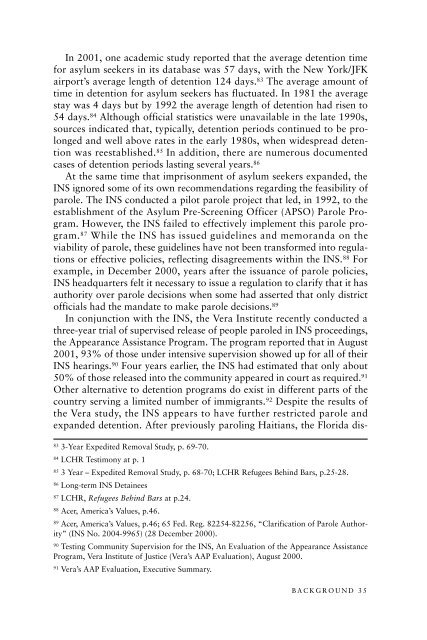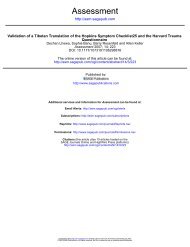From Persecution to Prison - Bellevue/NYU Program for Survivors of ...
From Persecution to Prison - Bellevue/NYU Program for Survivors of ...
From Persecution to Prison - Bellevue/NYU Program for Survivors of ...
Create successful ePaper yourself
Turn your PDF publications into a flip-book with our unique Google optimized e-Paper software.
In 2001, one academic study reported that the average detention time<strong>for</strong> asylum seekers in its database was 57 days, with the New York/JFKairport’s average length <strong>of</strong> detention 124 days. 83 The average amount <strong>of</strong>time in detention <strong>for</strong> asylum seekers has fluctuated. In 1981 the averagestay was 4 days but by 1992 the average length <strong>of</strong> detention had risen <strong>to</strong>54 days. 84 Although <strong>of</strong>ficial statistics were unavailable in the late 1990s,sources indicated that, typically, detention periods continued <strong>to</strong> be prolongedand well above rates in the early 1980s, when widespread detentionwas reestablished. 85 In addition, there are numerous documentedcases <strong>of</strong> detention periods lasting several years. 86At the same time that imprisonment <strong>of</strong> asylum seekers expanded, theINS ignored some <strong>of</strong> its own recommendations regarding the feasibility <strong>of</strong>parole. The INS conducted a pilot parole project that led, in 1992, <strong>to</strong> theestablishment <strong>of</strong> the Asylum Pre-Screening Officer (APSO) Parole <strong>Program</strong>.However, the INS failed <strong>to</strong> effectively implement this parole program.87 While the INS has issued guidelines and memoranda on theviability <strong>of</strong> parole, these guidelines have not been trans<strong>for</strong>med in<strong>to</strong> regulationsor effective policies, reflecting disagreements within the INS. 88 Forexample, in December 2000, years after the issuance <strong>of</strong> parole policies,INS headquarters felt it necessary <strong>to</strong> issue a regulation <strong>to</strong> clarify that it hasauthority over parole decisions when some had asserted that only distric<strong>to</strong>fficials had the mandate <strong>to</strong> make parole decisions. 89In conjunction with the INS, the Vera Institute recently conducted athree-year trial <strong>of</strong> supervised release <strong>of</strong> people paroled in INS proceedings,the Appearance Assistance <strong>Program</strong>. The program reported that in August2001, 93% <strong>of</strong> those under intensive supervision showed up <strong>for</strong> all <strong>of</strong> theirINS hearings. 90 Four years earlier, the INS had estimated that only about50% <strong>of</strong> those released in<strong>to</strong> the community appeared in court as required. 91Other alternative <strong>to</strong> detention programs do exist in different parts <strong>of</strong> thecountry serving a limited number <strong>of</strong> immigrants. 92 Despite the results <strong>of</strong>the Vera study, the INS appears <strong>to</strong> have further restricted parole andexpanded detention. After previously paroling Haitians, the Florida dis-833-Year Expedited Removal Study, p. 69-70.84LCHR Testimony at p. 1853 Year – Expedited Removal Study, p. 68-70; LCHR Refugees Behind Bars, p.25-28.86Long-term INS Detainees87LCHR, Refugees Behind Bars at p.24.88Acer, America’s Values, p.46.89Acer, America’s Values, p.46; 65 Fed. Reg. 82254-82256, “Clarification <strong>of</strong> Parole Authority”(INS No. 2004-9965) (28 December 2000).90Testing Community Supervision <strong>for</strong> the INS, An Evaluation <strong>of</strong> the Appearance Assistance<strong>Program</strong>, Vera Institute <strong>of</strong> Justice (Vera’s AAP Evaluation), August 2000.91Vera’s AAP Evaluation, Executive Summary.BACKGROUND 35



